Featured This Month
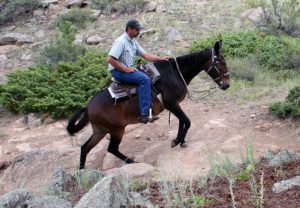
MULE CROSSING: On the Trail with Mules
By Meredith Hodges With the hectic schedule of spring and summer slowly tapering into fall, thoughts of cool, refreshing mountain streams, the sight of a massive bull elk, or the quiet majesty of the rugged mountain peaks on a relaxing trail ride, mountain hunt or pack trip begin to ease their way into our minds. What better time to share with your mule or donkey? What better place for him to show you what he was born to do? A mountain trail ride or pack trip are both perfect ways for you to get to really know your Longears and strengthen the bond between you. Mules are remarkably strong and durable animals, making them excellent mountain partners. The cupped shape of their hooves allows them to track the rough mountain terrain with much more surefootedness than their counterpart, the horse. A mule’s superior intelligence and strong sense of survival help him to carefully negotiate the placement of his feet, insuring the safest ride possible. This is both important and comforting to know when heading for the mountains. The mule’s strength and endurance are sometimes unbelievable, but always dependable. On a hunting trip, he will take you through rough mountain terrain ...
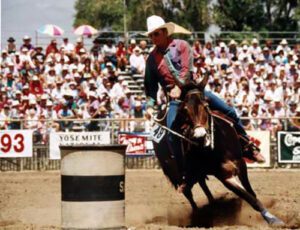
MULE CROSSING: Surge of Mule Shows
By Meredith Hodges I remember back in 1982 when summer came and we had to search high and low for shows in which we could compete with our mules! As they say, "You've come a long way, baby!" Mule shows are now so numerous that it is becoming very difficult to decide which ones to attend. Years ago, our mules were not necessarily welcome at horse competitions, and today that has changed as well – making our decisions about where to compete is even more complicated. It is truly amazing to see the tremendous growth in popularity of the mule over the past 30 to 40 years, but then I guess it was inevitable given all their redeeming qualities! It really isn't that unusual that people would begin to prefer mules once they received accurate and truthful information about them. Granted, you have to be smarter than the mule in order to train one, but once you train one properly, you have a wonderful companion and a top competitor in the equine world. More and more, the criticism of mules has changed to general curiosity and a willingness to learn more about these unique animals. Many people have taken a ...
All Articles

MULE CROSSING: Reflecting On Longears
By Meredith Hodges The contributions being made by mules and donkeys today are more numerous than they have ever been before and we should give thanks that we still have these Longears touching our lives and making them full! When the age of automation arrived, many mules, donkeys, and horses were put out of work. Mechanical alternatives were taking their places in the fields, in the coal mines, along the canals and even in the mountains. Horses made a somewhat smooth conversion of use to modern day recreation, but it was not as easy for the mules and donkeys. The history of mules and donkeys was never that well documented. Literally thousands of books have been written revering the horse for his contribution to the building of great societies and cultures. However, a lot of the things attributed to the horse were actually done by mules and donkeys! It does not surprise me that by 1966, mules and donkeys were on the decline. Their uses were no longer critical to development and growth of society. In 1967, concerned Paul and Betsy Hutchins founded the American Donkey & Mule Society, designed to spark the fires of interest in these longeared animals. The A.D.M.S. quarterly journal continues to remind the American public of all the extraordinary things that had been accomplished in history by donkeys and mules. They plowed the fields, pulled the covered wagons and worked in the coal mines. They pulled barges on the canals and packed munitions for the military. They built the Rose Bowl in Pasadena, California. Wild Bill Cody rode a mule named Mouse that put General Custer's fancy Thoroughbred to shame over long distances and rough terrain. The crowned heads of Europe rode mules as a statement of class and Jesus rode into Jerusalem on the ...
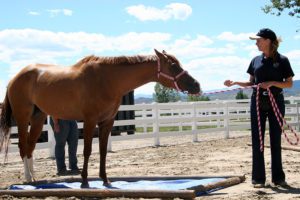
MULE CROSSING: Rewards, Treats, Coaxing and Bribing
By Meredith Hodges It is important to know the differences among rewards, treats, coaxing and bribing in order to correctly employ the reward system of training called Behavior Modification. Rule Number One: Treats and bribery should never be used during training. However, the appropriate dispensing of rewards and coaxing will produce the correct behaviors. In order to reward your equine correctly for performing tasks, it is important to know the difference between a reward and a treat, and between coaxing and bribing. Let’s begin with some basic definitions of these terms: Reward: something desirable given for a completed task Treat: an unexpected gift given simply because it will be enjoyed Coax: to gently persuade without dispensing the reward Bribe: to persuade the animal by indiscriminately dispensing treats Remember to give your equine a reward only after a specific task you’ve asked for has been performed—or even an assimilation of that task, which means the taking of baby steps toward completing the task. The reward should be given immediately upon completion of the task and then your equine should be allowed time to enjoy his reward before moving on to the next task. If your equine is given a food reward for only good behaviors, he will be more likely to continue to repeat only those behaviors for which he is rewarded and you can begin to “shape” his behavior in a positive way. Treats, on the other hand, are a food that your equine especially likes, which are given randomly and without purpose. Giving random treats during training can result in crossed signals and confusion in your animal. Treats such as peppermints and even “horse treats” are generally an inappropriate food source for equines and when dispensed too freely, have actually been known to cause equine health problems, so forego ...
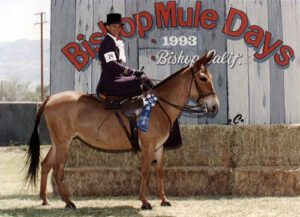
MULE CROSSING: Riding Side Saddle (Aside)
By Meredith Hodges INTRODUCTION I was born LOVING horses in Minneapolis, Minnesota in 1950. I got a pair of chaps and a “bouncing” horse when I was six years old. My Grandmother was always teaching me about Good Posture and Good Manners. She once wanted to take me on a shopping trip to the local mall and requested that I put on one of my frilly dresses. She told me that all the little girls would be wearing them and I flatly refused! You don’t ride horses in frilly dresses! I was a Tom-Boy all the way through! I didn’t want to be a boy, I just wanted to be READY TO RIDE! So, my Grandmother conceded and let me wear my pants! When we got back, she said, “See, I told you all the pretty little girls would be wearing dresses. Now don’t you wish you had worn yours?” “Nope,” I replied and she just shrugged! I still wore my dresses to church! We moved to California in 1958 when I finally got my first horse, Duchess! I was still very much a Tom Boy now...cleaning stalls, doing chores on the ranch and riding my horse. In 1961, I even joined 4-H and got 4 Hereford cattle. Now I was a REAL Cowgirl! In 1962, I finally got some jeans to wear my chaps over, a belt, cowgirl boots, proper Western shirts and a hat! Still, I learned feminine skills like cooking and sewing from my Grandmother, and still wore my dresses on Sunday! I was working on becoming a lady, but most of the time I was being a real Western girl! In 1973-79, I worked on my mother’s Windy Valley Mule Ranch training 30 weanlings a year to lead. In 1980, I moved to Colorado and started ...
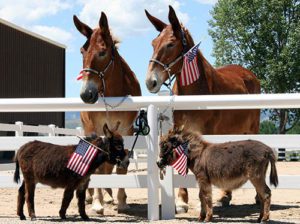
MULE CROSSING: Rock and Roll: Diary of a Rescue, Part 2
By Meredith Hodges In Part 1 of Rock and Roll: Diary of a Rescue, we learned about the discovery and rescue of Belgian draft mules, Rock and Roll, by Meredith Hodges and her team of experts. As the pair’s rehabilitation continues, the road to recovery gets tougher. But for every health setback, there is a personality breakthrough with these courageous and now-trusting gentle giants—and always a reason to hope. By May of 2011, both mules were beginning to bond well with me and I was able to separate them during workouts. I knew I would have to develop a strong bond with Roll in case Rock didn’t make it, and we all knew the odds were not in Rock’s favor. Being alone with me in the round pen helped Roll to concentrate on the tasks at hand. His way of going was markedly improving with each new lesson. Both mules could now square up properly and move in a much more balanced frame, although holding that balance was intermittent. The personality of each mule began to emerge and they became more willing to play games and to be touched and kissed about their heads. Rock was much more overt about his pleasure during the massages, and we could finally tell that they were beginning to trust us. By mid-June, we were able to take the pads off Rock’s back feet and reset the shoes without the pads. He had grown three-eighths of an inch of sole on both hind feet and the rotation began to improve in one back foot. Both mules were feeling much better and were actually engaging in play during turnout. Next, we discovered that due to the concussion to his rear feet from improper use during driving in the past, Roll had side bones in his right ...
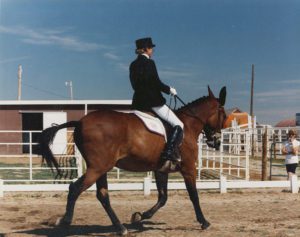
MULE CROSSING: Shoulder-In and Lengthening the Trot
By Meredith Hodges In order to perform the shoulder-in properly, it is important to understand its purpose. The shoulder-in causes the equine to engage his hindquarters so that they carry the bulk of his weight, giving him more freedom and suppleness in his shoulders and front quarters. A strong base must be established to carry this weight forward while the shoulders remain light and free to proceed forward while tracking laterally. The shoulder-in is done on a straight line. Normally, an animal traveling in a straight line makes two tracks in the dirt behind him, because the front legs are positioned directly in front of the back legs. In the shoulder-in, the shoulders are positioned so that they cause a three-track pattern behind—the inside front foot makes one track, the outside front foot and the inside hind foot make one track, and the outside hind foot makes one track. Begin by walking your equine around the perimeter of the arena. When you reach the corner before the long side, make a ten-meter (30-foot) circle. As you close your circle at the start of the long side of the arena, maintain the bend that you had for the circle, using steady pressure on your inside rein. At the same time, nudge your equine with alternate leg pressure in synchronization with his hind legs as they each go forward. Squeeze your outside rein at the same time that you squeeze with your outside leg, and then release the outside rein. Ride the hindquarters straight forward from your seat and legs, as you offset the shoulders with your hands. Be careful that your inside rein is not so tight that your animal bends only his neck to the inside. As you squeeze with the outside aids, feel your equine rock his balance back ...
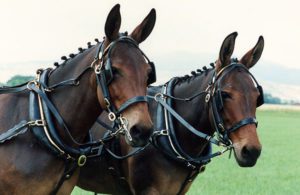
MULE CROSSING: Showing in Harness
By Meredith Hodges Now that you have spent many months teaching your mule to drive and he is doing so well, you have decided that it might be fun to show him in harness. So, what are that kinds of things that a judge looks for in a driving class of mules? Well, it's basically the same as it is with horses. The first and foremost consideration for a judge is your mule's manners. His manners will exhibit just how safe your mule is for driving. As with people, a judge can get an overall impression from the expression on your mule's face! An attentive and pleasant expression is definitely preferred. The expression on his face will reflect his overall comfort within a situation. If he is comfortable, he responds to minimal aids calmly, confidently, yet promptly. He should reinback easily upon request, and stand quietly at the halt with all four legs squared. His ears will be relaxed, but attentively turned to the driver most of the time. Ears that are rapidly in motion indicate anxiety and distraction. A major contributing factor in your mule's overall manners is his conditioning. If your mule has been brought along with a carefully planned exercise program, his muscle growth and strength will increase with little or no stress, as it should in most athletes. The mule that is conditioned in this way will have the strength to pull while maintaining a smooth, steady and effortless gait. He is comfortable in his work. Properly conditioned mules will not exhibit the tenseness that comes from overexertion, a tenseness that can inhibit his entire performance. How can you tell if your mule is well-conditioned? Touching his body with your fingers at the neck, shoulders, barrel, loins, stifles and rump can tell you a lot. These ...
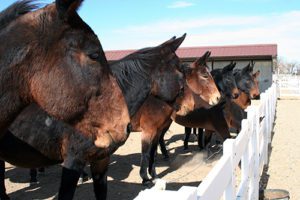
MULE CROSSING: Stubborn As A Mule
By Meredith Hodges “Stubborn as a mule” is hardly an appropriate cliché to describe today's mules who are sweeping the countryside with their remarkable abilities! But why now? Why haven't mules been used successfully as saddle animals before this? My only guess is that in the past, we did not afford ourselves much leisure time out of necessity. Therefore, mules used for packing and farming had to be broke quickly to help with the work. They were generally trained by older and more experienced animals by working in teams. People did not have the time to spend training one horse, much less one mule! If an animal refused to learn under the "team" plan, he was quickly discarded for an animal that would. Today we find that to train mules successfully for a variety of uses, we must spend a lot of quality time with them to get the desired response. Mules do not profit from hasty or forced training. With this new approach to training mules, they are rapidly becoming a preferred saddle animal. It does not seem strange to me that this phenomenon with mules is finally taking place. A mule usually inherits his strength and intelligence from the jack and his beauty and athletic ability from the mare. Of course, both the jack and the mare can contribute more and less, of each other's major attributes varying the looks and abilities of the offspring. Still, the offspring of a given mare will exceed the abilities of that mare after adding the jack's incredible strength and intelligence. It is no surprise, then, in the face of this evidence, that using an athletic, sport mare will produce a sport mule, and so on. In Europe, the Equestrian Arts are revered and preserved on a majority basis. In the ...
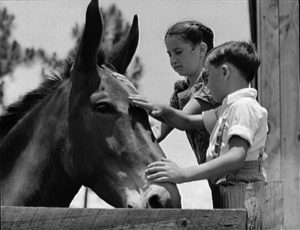
MULE CROSSING: Suitability of Donkeys and Mules For Children
By Meredith Hodges Many have inquired as to the suitability of mules and donkeys for children. As with any equine, choosing the right individual for your child is of primary importance. However, as a general rule, we find that donkeys make excellent mounts for beginning riders because of their patient, quiet nature and good common sense. They can be the best possible babysitter. There are things to consider when choosing a donkey for your child: The first rule to observe is never get a donkey jack for your child! Though he may be sweet and docile by nature, he is still governed by strong natural instincts so his character is not consistent. He is a stud and must be treated as such. Donkey jennets are good prospects for children provided they are not in heat or in foal. When a jennet is in heat she may become cross and if she is in foal, or has one at her side, she is also governed by instinct for the protection and welfare of her offspring. The best possible mount for a child is a donkey gelding. He possesses all the positive traits of the donkey without being subject to primitive instincts. Since most donkeys are small in size and possess an affectionate attitude, they make excellent companions as well as mounts for children. Since a donkey can became quite stubborn when treated badly, it is important that you take the time to help your child and donkey get started properly. Even an untried donkey with proper help can be a wonderful mount for a child. In the first few weeks, the child and donkey should simply spend time getting to know one another. Teach your child the correct way to handle and groom the donkey. The personal bond between them will ...

MULE CROSSING: Surge of Mule Shows
By Meredith Hodges I remember back in 1982 when summer came and we had to search high and low for shows in which we could compete with our mules! As they say, "You've come a long way, baby!" Mule shows are now so numerous that it is becoming very difficult to decide which ones to attend. Years ago, our mules were not necessarily welcome at horse competitions, and today that has changed as well – making our decisions about where to compete is even more complicated. It is truly amazing to see the tremendous growth in popularity of the mule over the past 30 to 40 years, but then I guess it was inevitable given all their redeeming qualities! It really isn't that unusual that people would begin to prefer mules once they received accurate and truthful information about them. Granted, you have to be smarter than the mule in order to train one, but once you train one properly, you have a wonderful companion and a top competitor in the equine world. More and more, the criticism of mules has changed to general curiosity and a willingness to learn more about these unique animals. Many people have taken a great deal of time and effort to bring these animals into the public eye. To name them all would take volumes, but their work is certainly appreciated! As I said, there are many all-mule and donkey shows that you can attend in most states across the U.S. Most of them are held in conjunction with State Fairs. However, there are others that are promoted with horse and mule races as well. The American Donkey & Mule Society sponsors a National Mule and Donkey Show that floats from state to state. The 1992 A.D.M.S. Nationals were held in conjunction with the ...
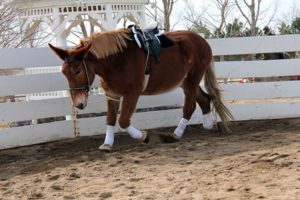
MULE CROSSING: The Equine in Motion
By Meredith HodgesI have done extensive work in training equines for many years and it seems you can never learn enough. If you learn how to ask the right questions, there is always something more to learn just around the corner. It is no secret that things can happen when you push limits and you can get what might seem to be the right results, but then you have to ask yourself…really? You may, for instance get your young Reining prospect to do a spin, but then you should ask yourself if he is executing it correctly so as not to injure the ligaments, tendons and cartilage in his body. If he is not adequately prepared for the spin with exercises that address his core muscle strength and good posture, then he is likely to do the movement incorrectly, putting his body at risk.Horse trainers have kept us in awe of their unique and significant talents for centuries, and now that their techniques are more public, many equine professionals will pooh-pooh those who attempt a “kinder” approach to training. Scientists who study the equine in motion—its nutrition, biomechanics, care and maintenance—have their own perceptions to offer as to what we can learn about equines. Because many of these studies and tests are done in the laboratory, scientists rarely have the opportunity to follow their subjects throughout a lifetime of activity, as well as having the opportunity to experience what it really means for you as a rider, to be in balance with your equine when you work together, whether you are leading, lunging, riding or driving. If they did, their findings would probably yield quite different results. With all this progressive scientific thought, it seems to me that common sense can often get lost in the shuffle and respect for ...
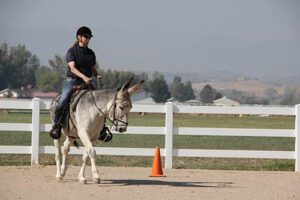
MULE CROSSING: The Hourglass Pattern & The Elbow Pull
(A SELF-CORRECTING POSTURAL AID FOR EQUINES) Concept Developed by Richard Shrake and Specific Design by Meredith Hodges (Trademarked & Published in TRAINING WITHOUT RESISTANCE 2003) In my TRAINING MULES & DONKEYS DVD #2, in the TRAINING WITHOUT RESISTANCE manual (2003) and in the SPECIAL FEATURES of my EQUUS REVISITED DVD (2009), I talk about using a postural aid called the "Elbow Pull." In the EQUUS REVISITED DVD, we teach you how to measure it for your individual equine and how to make it. If you have our video series, in DVD #2, in the TRAINING WITHOUT RESISTANCE manual (2003) and in the EQUUS REVISITED DVD (2009), we talk about using the "Elbow Pull." We teach you how to measure it for your individual equine and how to make it. The “Elbow Pull” puts your animal into your equine's ideal posture. He will have full range of motion in every direction when it is adjusted correctly. He will just not be able to raise his head so high that he hollows his neck and back. He will be able to balance and adjust his body position, encourage the hind quarters to come underneath his body when he is walked, or driven forward. Allowing the equine take short steps, front and back, would let the back sag (swayback-Lordosis) and does not engage the abdominal muscles. The “Elbow Pull” encourages the equine to stretch his spine, round his back and neck upwards (not "hump" it!) and elevates the shoulders when he steps underneath his body. The elevation (or suspension) in the shoulders allows him to increase the “reach” in his front legs. I use the "Elbow Pull" for Leading Training, Ground Driving and when he is ready, Lunging in the Round Pen. The Leading Training on flat ground through our HOURGLASS PATTERN positively ...
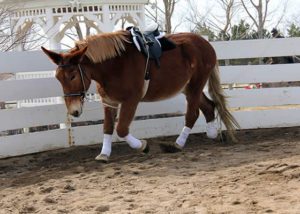
MULE CROSSING: The Ins and Outs of Leg Supports
By Meredith Hodges There are so many equine-related products on the market today that it is difficult to decide which ones you really need and which ones you don’t. For instance, the subject of splint boots and leg wraps can be very confusing. How do you know when to use them? What types of leg wraps or splint boots are best? Do they really help? In what ways do they help? What type of material should they be made from? And the list of questions goes on. Splint boots and leg wraps vary as much as their uses. The easiest and most obvious use of a leg wrap comes when traveling with your equine. If you are taking your animal any real distance, it is always advisable to use full cover, padded shipping boots on all four legs. The shipping wraps help prevent your animal from injuring himself due to his own movements, on objects inside the trailer or because of other animals that are traveling with him. If you have an animal that is fidgety and has difficulty standing still, applying leg wraps is the perfect opportunity to teach him to stand quietly while you handle his legs. You can begin training for leg wraps by putting them on your equine while he is outside the trailer in your grooming station, and then removing them in the trailer before unloading. Make sure he is standing quietly while you put the leg wraps on him. Also, get in the habit of always removing the leg wraps while he is still in the trailer. This makes him learn to “wait” for you before he departs the trailer. If he expects to have his wraps removed while he is still in the trailer, he is less likely to become excited and possibly ...
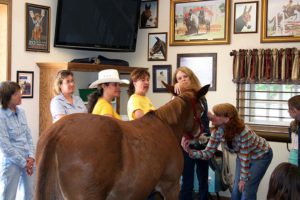
MULE CROSSING: The Language of Longears
By Meredith Hodges Many of you know me as the foremost authority on the contemporary saddle mule, but what you may not know is how I earned such a title. Most of us who have become trainers began by riding and showing. Through our success, we gained recognition and subsequently clients who brought their animals to us for training. Our success with their animals posed a question for each of us at a critical stage in our careers and we had to make a decision whether we were going on the road to do clinics or something different. I opted for something different! Instead of going on the road to do clinics, I thought long and hard and decided to do an equestrian correspondence training course instead. I opted for this after considering that when I went to clinics as a student, I was one of 20 people and only got limited attention during those clinics. When I put into practice at home what I had learned at the clinics, I realized that I had only received the highlights of training and it was full of holes! When I tried to contact the clinicians to ask a question, I was either answered by someone in the office, or not answered at all. The clinicians were most often too busy and out of touch. The one thing I didn’t realize by making this decision was the incredible learning opportunity I had opened up for myself that I could, in turn, pass on to my clients. I did my resistance-free video training series in as much detail as I could possibly muster. Each video represents a year’s worth of training, but as we all come to know, you can never know everything. The more you learn, the more you learn what you ...
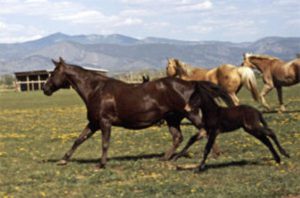
MULE CROSSING: The Mule Foal
By Meredith Hodges Mules and donkeys have an inborn natural affinity for human beings, so raising your mule or donkey foal to accept humans can be a relatively easy task if you remember a few simple things. First and foremost, you must learn to be a willing role model and, at all times, be polite, considerate and respectful toward your foal in what you ask and how you ask it. Second, you must remember that, from the moment your foal is born, he will learn a great deal from his dam. He will spend the first five to six months with her, so if you want your foal to be friendly and cooperative, then you should first be sure that his dam is friendly and cooperative. A mule or donkey foal from a “sour,” or uncooperative dam will, despite his deeper instinct to be amicable towards humans, eventually learn to mimic her avoidance behaviors. For instance, if your mare or jennet leaves when you approach, the foal at her side eventually learns to leave as well—whether he is truly frightened or not—and this can carry over into his adulthood. That is not to say that you cannot teach the mare and her foal to both be more amicable at the same time, but it is much less time-consuming and frustrating to train your mare to be friendly and cooperative before she gives birth. Mule foals are not too much different than human infants in their emotional needs. They require lots of attention, love, guidance and praise if they are to evolve into loving, cooperative and confident adults. In your efforts to get your young foal trained, bear in mind that he is still a child. If he is expected to fulfill too many adult responsibilities too quickly, he can become ...
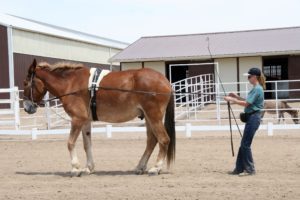
MULE CROSSING: The Rein Back
By Meredith Hodges Many common horse training techniques used today work well on either horses or mules. However, being creative and using less technique with a more logical approach to training works better with donkeys. In the case of the “rein back,” the problems are universal. Some equines seem to “rein back” more easily than others. Similarities exist within the equine species regarding personality types, but there are also differences in environmental behavior during training. Horses that are resistant to backing either shake their heads violently from side to side or rear up and try to throw themselves over backwards. Resistant mules try to walk sideways or forward, and resistant donkeys are either stone statues or terrific “leaners.” All of these tendencies are an expression of discomfort in the equine and can pose serious problems for the trainer. In order to get the best results, before teaching an equine to “rein back” you must understand the animal’s body mechanics and his mental attitude. The “rein back” is a reverse, two-beat, diagonal gait. When executing a straight “rein back,” the equine is unable to see what is directly behind him, but he can see peripherally on both sides. Because of the way the eyes are set in their head, mules can actually see all four feet when facing straight forward where a horse cannot. The depth perception of an equine is questionable at best, but when an equine must “rein back,” his vision is even more impaired because he can’t see directly behind him. This causes him to become tense because the equine must trust the trainer not to back his precious little rear into anything that might hurt him! If the trainer has been even a little abusive in the past, the equine will not be able to trust and ...
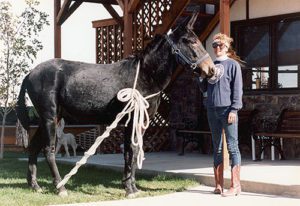
MULE CROSSING: The Responsible Use of Restraints in Training
By Meredith Hodges There is a lot of discussion about training mules versus training horses. There are some who say that mules are harder to train than horses and others who say just the opposite. It has been my experience that it isn’t really that one animal is more “difficult” than the other. They each have their own redeeming qualities and individual limiting factors. The people who are dealing with them also have their own redeeming and limiting factors. For instance, if you are leading a horse and he does not wish to follow you, because he hasn’t the strength in his head and neck as a donkey or mule and can be more easily bullied into complying with a quick jerk on the lead rope. On the other hand, if you are leading a mule or donkey, they can easily jerk the rope right out of your hands because of the incredible strength they have in their head and neck. When you teach a mule or donkey something one day, he will ponder what he has been taught during the days in between lessons. He will comply more easily during the next lesson. Regardless of how many days or weeks have passed between lessons, the horse will tend to forget and will need to be reminded where the mule or donkey will not. It makes sense that the handler needs to adjust his training program such that the horse has more frequent and consistent lessons to refresh his memory. The mule will only need lessons as frequently as it takes to maintain good physical condition. When applying lessons more frequently, the handler has the ability to make subtle adjustments to get the best from the horse. If he wants the mule or donkey to react properly, it is critical ...
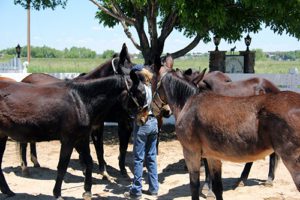
MULE CROSSING: Train for the Pleasure of It
By Meredith Hodges As humans, we tend to complicate our lives—filling them with people, things, goals and tasks, until we’re too busy to think. For a mule or donkey (and even other equines), it’s different. The equine has no “to do’s,” no “ought-have’s,” or “ought-to’s.” He takes things as they come, considers his response in the moment, and stays open to possibility. This year, why not resolve to be more like your mule or donkey? Consider your priorities and look at your relationship with him from his perspective. Stop to smell the roses, and during those inevitable challenging moments, put yourself in your mule’s shoes. Think like he does and you may be surprised at the response you get. No doubt, this is a tall order. After all, we humans tend to begin with the end in mind, and the process is just a means to that end. Training, for example, is a process. We attempt to train with a goal in mind. Our goal at the Lucky Three Ranch is to improve the equine’s performance as well as our own. Most of us train with the expectation that improvement will occur, and most of us add the self-imposed pressure to improve within a certain amount of time. The notion that the training—the process itself—could be the goal is foreign to many of us. But consider it. What if we trained for the pure pleasure of spending time with our equine while using the values we hold dear like respect, kindness, consideration and consistency in our behavior? How different would the experience be for us and for him? Today’s general horse training techniques do not generally work well with mules and donkeys. Most horse training techniques used today speed up the training process so people can ride or drive sooner ...
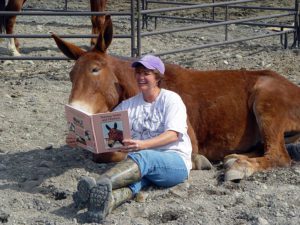
MULE CROSSING: Train Your Own Mule!
By Meredith Hodges Mules and donkeys are wonderful animals. They’re strong, intelligent and what a sense of humor! But training a mule or donkey is different from training a horse. They require love patience, understanding and a good reward system. Negative reinforcement should be used sparingly and only to define behavioral limits. The result is an animal that is relaxed, submissive, obedient, dependable and happy with his work. Mule and donkey owners find it difficult to find trainers for their Longears because most horse trainers are unfamiliar with the psychological needs required by Longears to invoke positive responses from them. Those trainers who are capable are few and far between, making it difficult for inexperienced owners in remote areas to get their animals trained properly. Many people attempt to train their own animals and achieve a certain level of success despite the trials and tribulations of trial and error. This can be a long and frustrating road. We are fortunate enough today to have all kinds of books and videos available on training Longears. However, it wasn’t that long ago when there was virtually nothing published on this subject. Those of us who were training needed to use educational resources published on horse training and modify those techniques to better suit our Longears. This still left a lot of room for trial and error…and frustration for both the trainer and the animal. Interest in Longears has grown tremendously over the past 50 years. With this increased interest has come an increase in the numbers of animals that need to be trained each year. The few trainers who are competent with Longears could not possibly train even most of the animals that need it, even if it were geographically possible—which it isn’t. Owners usually need to travel distances to visit an animal ...
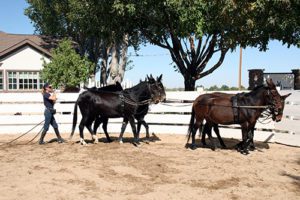
MULE CROSSING: Training for Health, Happiness and Safety
By Meredith Hodges Whether you just want to use your equine for pleasure riding or for show, the way your equine should be managed is still the same. He still needs to be fed, managed and trained correctly for optimum health and performance in order to be a safe, happy and healthy companion. What you do with him each and every day lays the foundation for future challenges. When he is schooled in a logical and sequential way that allows muscles to be slowly and symmetrically strengthened in good equine posture, he will feel better overall than the equine that is not schooled this way. He will not only be able to do tasks safely and more easily, but will actually be happy and have fun engaging with you. The incidence of resistant behaviors becomes practically non-existent. Taking shortcuts with training will never produce the trust and confidence of an equine that is logically and sequentially schooled. Even pleasure riding produces physical challenges. Balance in good posture separates the winners from the rest at shows and other public events. Encouraging good manners and offering the food reward of oats will begin positive negotiation with your equine right from the beginning. He will eagerly learn to look forward to his time with you. The food reward assures that good behaviors will be repeated and your consistency in routine will transform the equine into one that remains calm, that will ultimately stand quietly upon request. Being promptly rewarded for confidence and bravery during the execution of fearful tasks such as negotiating obstacles will begin to lay a foundation of trust between you. When your equine trusts your judgment, trail loading and similar tasks are no problem at all. He will follow you anywhere, anytime…even in stormy weather! Teaching your equine to execute ...
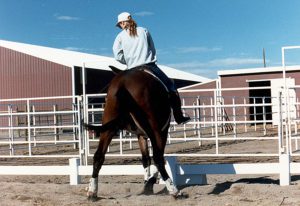
MULE CROSSING: Turns On the Forehand and Haunches
By Meredith Hodges Proper conditioning of the young equine through a carefully sequenced program of gymnastic exercises is essential to the proper development of his mind and body. Spending time cultivating a smooth, fluid forward motion with rhythm and cadence will help him to develop properly and enable him to perform difficult movements more easily. Work with ground rails and cavalletti helps to build muscle, particularly in the hindquarters, which will help him carry your weight more easily through lateral movements, stops and lengthenings. Proper preparation minimizes resistance and frustration which will be apparent by the way your animal carries his tail. You may have noticed after the introduction of a few simple lateral movements, that your equine’s forward motion has become a little shaky again. It is now time to clarify to your animal the connection between forward motion and lateral motion. With his increased understanding of your seat and legs and by using a few simple exercises, this should be a fairly simple process. Ask your equine to walk a 20-meter (approximately 60 foot) circle, maintaining rhythm, cadence, proper flexion and bend. Then, in rhythm, change your aids to a slight counter bend and ask for a turn-on-the-forehand, sending his haunches in toward the center of the circle until he is reversed. At the precise instant he is in position to start following the circle in the opposite direction, release your pressure on the reins and send him forward again with your legs onto the new circle in the opposite direction. You will find that you must hold him back a little with the reins through the turn-on-the-forehand to keep his weight on his hindquarters through the turn, but to maintain the forward motion, it is critical that the release comes at the instant he has completed the ...
